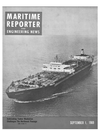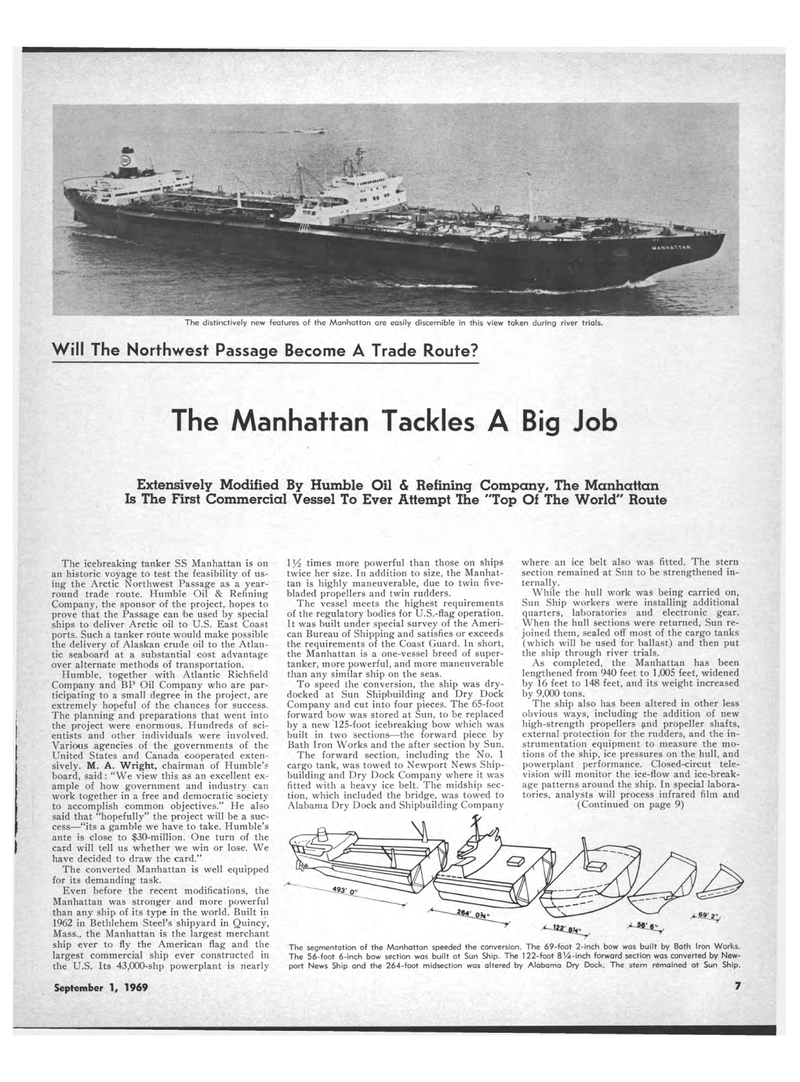
Page 5: of Maritime Reporter Magazine (September 1969)
Read this page in Pdf, Flash or Html5 edition of September 1969 Maritime Reporter Magazine
The distinctively new features of the Manhattan are easily discernible in this view taken during river trials. Will The Northwest Passage Become A Trade Route? The Manhattan Tackles A Big Job Extensively Modified By Humble Oil & Refining Company, The Manhattan Is The First Commercial Vessel To Ever Attempt The "Top Of The World" Route The icebreaking tanker SS Manhattan is on an historic voyage to test the feasibility of us-ing the Arctic Northwest Passage as a year-round trade route. Humble Oil & Refining Company, the sponsor of the project, hopes to prove that the Passage can be used by special ships to deliver Arctic oil to U.S. East Coast ports. Such a tanker route would make possible the delivery of Alaskan crude oil to the Atlan-tic seaboard at a substantial cost advantage over alternate methods of transportation. Humble, together with Atlantic Richfield Company and BP Oil Company who are par-ticipating to a small degree in the project, are extremely hopeful of the chances for success. The planning and preparations that went into the project were enormous. Hundreds of sci-entists and other individuals were involved. Various agencies of the governments of the United States and Canada cooperated exten-sively. M. A. Wright, chairman of Humble'? board, said: "We view this as an excellent ex-ample of how government and industry can work together in a free and democratic society to accomplish common objectives." He also said that "hopefully" the project will be a suc-cess?"its a gamble we have to take. Humble's ante is close to $30-million. One turn of the card will tell us whether we win or lose. We have decided to draw the card." The converted Manhattan is well equipped for its demanding task. Even before the recent modifications, the Manhattan was stronger and more powerful than any ship of its type in the world. Built in 1962 in Bethlehem Steel's shipyard in Quiney, Mass., the Manhattan is the largest merchant ship ever to fly the American flag and the largest commercial ship ever constructed in the U.S. Its 43,000-shp powerplant is nearly 1 y2 times more powerful than those on ships twice her size. In addition to size, the Manhat-tan is highly maneuverable, due to twin five-bladed propellers and twin rudders. The vessel meets the highest requirements of the regulatory bodies for U.S.-flag operation. It was built under special survey of the Ameri-can Bureau of Shipping and satisfies or exceeds the requirements of the Coast Guard. In short, the Manhattan is a one-vessel breed of super-tanker, more powerful, and more maneuverable than any similar ship on the seas. To speed the conversion, the ship was dry-docked at Sun Shipbuilding and Dry Dock Company and cut into four pieces. The 65-foot forward bow was stored at Sun, to be replaced by a new 125-foot icebreaking bow which was built in two sections?the forward piece by Bath Iron Works and the after section by Sun. The forward section, including the No. 1 cargo tank, was towed to Newport News Ship-building and Dry Dock Company where it was fitted with a heavy ice belt. The midship sec-tion, which included the bridge, was towed to Alabama Dry Dock and Shipbuilding Company where an ice belt also was fitted. The stern section remained at Sun to be strengthened in-ternally. While the hull work was being carried on, Sun Ship workers were installing additional quarters, laboratories and electronic gear. When the hull sections were returned, Sun re-joined them, sealed off most of the cargo tanks (which will be used for ballast) and then put the ship through river trials. As completed, the Manhattan has been lengthened from 940 feet to 1,005 feet, widened by 16 feet to 148 feet, and its weight increased by 9,000 tons. The ship also has been altered in other less obvious ways, including the addition of new high-strength propellers and propeller shafts, external protection for the rudders, and the in-strumentation equipment to measure the mo-tions of the ship, ice pressures on the hull, and powerplant performance. Closed-circut tele-vision will monitor the ice-flow and ice-break-age patterns around the ship. In special labora-tories, analysts will process infrared film and (Continued on page 9) The segmentation of the Manhattan speeded the conversion. The 69-foot 2-inch bow was built by Bath Iron Works. The 56-foot 6-inch bow section was built at Sun Ship. The 122-foot 8V4-inch forward section was converted by New-port News Ship and the 264-foot midsection was altered by Alabama Dry Dock. The stern remained at Sun Ship. z 69'2<. A-SSU^ September 1, 1969 7

 4
4

 6
6
